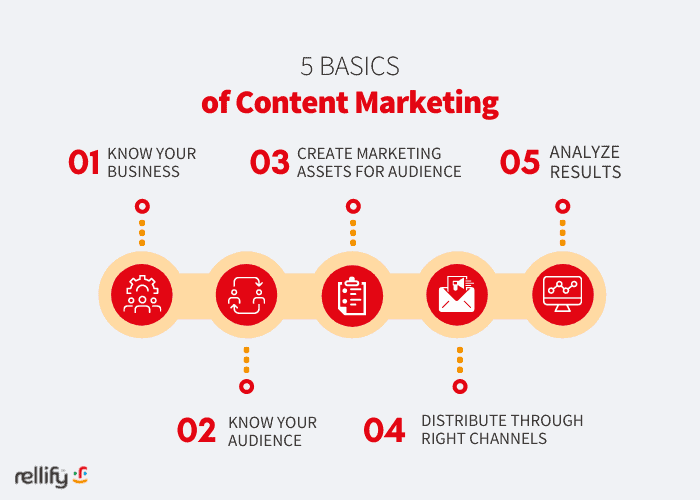Content Marketing: Everything You Need to Know

With the rise of the internet, traditional marketing strategies are changing. In this new landscape, one approach stands out: content marketing.
But what is it all about? How can you use different types of content to reach your goals?
This article will answer these questions and more. But first, let's break down the basics of content marketing.
What is Content Marketing?
Content marketing is all about two things:
content creation and the
distribution of that content with the world. This sharing happens through a variety of ways, like social media, emails, and websites. The content itself can be words, spoken word, or even pictures and videos. It all helps organizations, whether businesses or charities, achieve their goals.
Content marketers share a simple mission: to tell their company's story in a way that grabs attention and reaches the right people. They craft engaging content that sparks interest and guides them towards becoming happy customers. To make this happen, they plan a smart marketing strategy that spreads their message and turns readers into paying fans.
Even though both content marketing teams want the same thing (more leads!), how they get there can be totally different. One team might focus on social media and using things people create (like videos or posts) as part of their plan. Another team might write detailed reports and send them out to people via email.
The Content Marketing Industry
Don't stress about the exact details of your content plan, it can change anyway! New trends might pop up and shift things around. The important thing is to know what you're trying to say and create stuff that explains it clearly. If people get it and do something because of it, you're on the right track!
Think of content marketing like a giant network of people working in almost 90% of marketing companies. It's a big deal, and a study from 2021 says most marketers expect their budgets for this kind of marketing to grow. So, yeah, content marketing isn't going anywhere anytime soon.
What is the Role of Content Marketing?
Brands can talk to their customers in many ways through content, like blog posts, videos, or social media. What they say depends on who they're trying to reach and where those people are in their "customer journey" (like whether they're new or loyal).
For example, a cool picture on Instagram might be great to grab attention and attract new customers. But it's not the best way to talk to longtime customers who already trust your advice. L
Content marketing has a lot to offer! It helps people know more about your brand, understand what you do and why it matters, and even encourage them to do something about it.
How Do You Do Content Marketing?
[caption id="attachment_412" align="alignnone" width="700"]

5 Components of Content Marketing[/caption]
Forget magic formulas – content marketing isn't about one perfect recipe. But there are five easy steps to get you cooking up awesome content even if you're just starting out!
- Get to Know Your Stuff: Before diving in, understand what you're selling and what you hope to achieve. This is like knowing your mission before starting any adventure!
- Who Are You Talking To?: Picture your ideal customer. What are they like? Where do they hang out online and offline? Understanding them helps you speak their language.
- Give the People What They Want: Different folks, different strokes! Create content and materials (think pictures, videos, articles) that resonate with each customer type you identified in step 2.
- Spread the Word: Put your awesome content on the platforms your audience uses most. Think of it like sharing your cool stories on the playgrounds they frequent!
- Learn and Grow: Check how things are going. What content gets people excited? What flops? This helps you refine your approach and keep things fresh.
Have it in that you're emailing news updates or making fun videos, if your audience connects with your brand, you're on the right track!
What are Some Content Marketing Examples?
Content marketing isn't just about blogs and articles! It can be all sorts of cool stuff, like pictures with info (infographics), moving pictures (videos), and even your voice on the radio (podcasts).
Here are some popular types of content marketing that can help you reach your audience and grow your brand. If you're new to this, don't be shy to try different things and see what works best!
Blogs
These can be short or long and are a great interactive way for customers to interact with a new potential customer or faithful, loyal customers. Sometimes companies will use blogs to answer customer questions. Other times, they’ll write evergreen content related to a critical issue the audience cares about.
Long-form content
You can describe anything over 1,000 words as “long-form content.” This data often lives on blogs, articles, and white papers. Long-form content gives readers a more in-depth look at specific insights or goals a company has and has become increasingly important for search engine optimization. It’s an excellent way for brands to showcase their unique insights and expertise.
A few tips for content marketing tips for written forms
No matter where you are in the blogging or writing process, here are a few tips to make sure your blogging efforts are effective content marketing for your brand and audience.
- Post consistently on topics related to your business that your audience cares about. You’re better off posting a few quality blogs that are well-researched and engaging and posting once a week or so, than posting sub-par information.
- You can post educational content related to your subject area or brand to let your readers know your expertise.
- Optimize your blog for search engines. You want to make sure new users are learning about your blog.
- Your posts should address common questions your readers have regarding your product and industry.
- Aim for quality over quantity. Writing can be such an effective content marketing tool, but bad writing will cripple any content marketing campaign.
Videos
Whether they’re expert interviews or short animated explainer clips, video can be valuable content to have in your arsenal. Be smart about using video as part of your overall content marketing strategy. Video can be a compelling form of content marketing, but a poorly produced or conceived video can backfire.
You don’t have to invest in ridiculous editing equipment for high production quality, but your videos need to look good and make sense.
When done well, video has the power to explain complex concepts or showcase products in ways that can be highly appealing and relatable to potential customers.
Infographics
These specific images with details or charts about the company can exist within other types of channels, like a blog or white paper. Other times, they’ll stand independently as a post on a social media channel. But regardless of where you find an infographic, it’s a powerful way to convey complex data in a simple format. It’s also a tremendous business asset that you can place on several forms, from PowerPoint presentations to LinkedIn posts or even within a promotional video.
Content Marketing Channels
How to spread the word about your awesome content? Th
ere are many ways to share your content online, like on your website, social media, or other online spaces. The best way is to use a mix of these channels to reach more people and achieve your goals.
Not sure where to begin? Start with a website and social media accounts for your business. This makes it easy for people to find and see your cool stuff online.
Website
Your website doesn't need to be overloaded with flashy stuff like videos and graphics. In fact, too much of that can make your website slow and take away from what really matters: the information you want to share.
A basic website that gets the job done is just fine. It should explain what your company does, how people can find you, and maybe even have a blog with interesting articles. This kind of simple website can be a powerful tool for content marketing.
Email campaigns
Got email addresses of happy customers or even bought a list? Great! Now you can send them your cool online stuff. But be careful! Sending emails, especially to people who didn't ask for them, can be annoying. Imagine getting daily emails from a company you never heard of – not fun! But for your loyal fans, who already love your stuff, special offers and company news will be like a treat.
Direct mail
This form of traditional marketing has been around for years and can be a very effective strategy for marketers. It involves sending letters, catalogs, coupons, or any written and visual content marketing materials to your targeted audience.
Social media
Sharing things you've made on social media is a great way to get them seen by more people. You can post pictures with words (infographics) on Instagram, quick videos on TikTok, or even longer articles on LinkedIn.
Social media makes it easier to talk directly to your fans and customers. Posts on these platforms are more like having a conversation than other ways of sharing things. Not only can you chat with your audience, but they can talk to each other too, like a big club. Sometimes, you can even use things your fans make and share them on your social media. This makes your stuff seem more real and relatable.
[caption id="attachment_413" align="alignnone" width="700"] Share your content across social media channels.[/caption]
Share your content across social media channels.[/caption]
Which social channels are the right ones for your business?
The type of content you share on social media matters! It depends on where you're posting, who you're talking to, and what you want to achieve.
For example, a bank trying to reach other businesses (B2B) would have more luck with long, detailed articles and cool graphs on LinkedIn than with silly dance videos on TikTok.
When considering social media channels for content marketing, content marketers should first consider these questions.
- What is the goal of my marketing campaign?
- Do I have a clearly defined audience, and what types of social media is that audience engaging with?
- What’s the best fit for my audience?
There’s nothing wrong with trying out several different content marketing strategies. Just be sure you’re measuring those results to see where you should spend time and what’s not helping you get your message across.
Paid Marketing Campaigns
Think of paid ads like a rocket engine for your content. You can use them on different platforms like Facebook, app stores, or even podcasts. These ads give your existing content, like blog posts or your app, an extra push and help more people find it. So, instead of waiting for people to stumble across your stuff, paid ads actively bring them closer.
While these tactics can be effective, especially on search advertising, organic results almost always outperform paid search. That’s not to say paid searches can’t be extremely helpful at increasing your distribution, but the overwhelming majority of searchers click on the first organic link.
What do you share for a paid campaign? Start by looking at what’s already performing well among your loyal supporters. What worked on social? Which emails have high click-through rates? Then refine that and bring it to a broad audience through your paid campaign.
What is Good Content Marketing?
Good content marketing is all about connecting with the people you're trying to reach. This can be done in many ways, but some things usually make content marketing really good:
- Fresh content posted on a regular basis. It’s not enough to write one blog post and hope it goes viral. Your brand and content should stay fresh in your prospective and existing customers’ minds.
- Incorporates editorial calendars. Don’t just haphazardly add articles to your blog. Set aside some time each month to make a monthly content calendar that allows you to create relevant content across strategic topic areas.
- Utilizes an effective email marketing strategy. When used strategically, email lists can be a fantastic way to reach your target audience.
- Effective use of visuals. A picture is worth 1,000 words, and visual content can be an extremely effective marketing technique. Just remember to add relevant titles and labels to your photos for search engine optimization.
- SEO-Optimized content. Organic search can be a wonderful way to get users to your site, and your content marketing strategy needs to consider technical elements of SEO that support your great writing and articles.
- Evaluated consistently with analytics. There’s no shortage of tools or analytical metrics for digital marketing efforts. Check out how many people are opening your emails, and which ones have a better open rate. Which piece of content is getting to the top of SERPs, and how are users responding after coming to your website? Are you getting strong conversions from inbound marketing efforts?
Extra Content Marketing Resources
Writing great content can be tough, even for pros! Making it catchy and reaching lots of people online is even harder.
But good content marketing is still possible, especially with a little help! If you need more tools to create awesome content that shows up in searches and connects with readers, Rellify can help! They mix human expertise with smart tech made just for your business to supercharge your content game.


 5 Components of Content Marketing[/caption]
5 Components of Content Marketing[/caption] Share your content across social media channels.[/caption]
Share your content across social media channels.[/caption]



Leave a comment